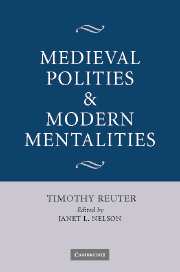Book contents
- Frontmatter
- Contents
- Editor's note
- Acknowledgements
- List of abbreviations
- Editor's introduction
- PART I MODERN MENTALITIES: HISTORIOGRAPHIES, METHODOLOGIES, PRECONCEPTIONS
- PART II THE SYMBOLIC LANGUAGE OF MEDIEVAL POLITICAL ACTION
- PART III POLITICAL STRUCTURES AND INTENTIONS
- 11 Assembly politics in western Europe from the eighth century to the twelfth
- 12 Sex, lies and oath-helpers: the trial of Queen Uota
- 13 Plunder and tribute in the Carolingian empire
- 14 The end of Carolingian military expansion
- 15 The Ottonians and Carolingian tradition
- 16 The making of England and Germany, 850–1050: points of comparison and difference
- 17 King, nobles, others: ‘base’ and ‘superstructure’ in the Ottonian period
- 18 The ‘imperial church system’ of the Ottonian and Salian rulers: a reconsideration
- 19 Peace-breaking, feud, rebellion, resistance: violence and peace in the politics of the Salian era
- 20 The medieval German Sonderweg? The empire and its rulers in the high Middle Ages
- 21 Mandate, privilege, court judgement: techniques of rulership in the age of Frederick Barbarossa
- 22 All quiet except on the Western Front? The emergence of pre-modern forms of statehood in the central Middle Ages
- Index
14 - The end of Carolingian military expansion
Published online by Cambridge University Press: 12 August 2009
- Frontmatter
- Contents
- Editor's note
- Acknowledgements
- List of abbreviations
- Editor's introduction
- PART I MODERN MENTALITIES: HISTORIOGRAPHIES, METHODOLOGIES, PRECONCEPTIONS
- PART II THE SYMBOLIC LANGUAGE OF MEDIEVAL POLITICAL ACTION
- PART III POLITICAL STRUCTURES AND INTENTIONS
- 11 Assembly politics in western Europe from the eighth century to the twelfth
- 12 Sex, lies and oath-helpers: the trial of Queen Uota
- 13 Plunder and tribute in the Carolingian empire
- 14 The end of Carolingian military expansion
- 15 The Ottonians and Carolingian tradition
- 16 The making of England and Germany, 850–1050: points of comparison and difference
- 17 King, nobles, others: ‘base’ and ‘superstructure’ in the Ottonian period
- 18 The ‘imperial church system’ of the Ottonian and Salian rulers: a reconsideration
- 19 Peace-breaking, feud, rebellion, resistance: violence and peace in the politics of the Salian era
- 20 The medieval German Sonderweg? The empire and its rulers in the high Middle Ages
- 21 Mandate, privilege, court judgement: techniques of rulership in the age of Frederick Barbarossa
- 22 All quiet except on the Western Front? The emergence of pre-modern forms of statehood in the central Middle Ages
- Index
Summary
It is a commonplace that the expansion of the Carolingian empire slowed down rapidly after 800 and came to a halt under Louis the Pious. It is also well known that both Charles in the last years of his reign and Louis the Pious experienced difficulty in raising armies. This paper will re-examine these two well-established facts and suggest some explanations, continuing lines of argument already developed in a previous article. It may be as well to begin by chronicling the end of expansion. The crushing of the Avars in the 790s was the last really large aggressive military operation conducted by the Carolingians; the final incorporation of the Saxons into the Frankish empire, marked by the peace of Salz in 803 and the de-Saxonization of Transalbingia in the following year, brought to an end what Einhard rightly described as the most serious of all the wars fought by the Franks. In the period between 802/3 and the crisis of 830 there was intermittent warfare on a number of fronts: in the south-west against the Muslims of Spain and the Basques; in the north-west against the Bretons; in the north-east against the Danes and their Slav allies; in the south-east against the Serbs and the Bulgars; and in Italy against the Byzantines and Beneventans. In addition there were invasion scares in the 800s on the north French coast, real invasions in southern Italy and Frisia, and skirmishes in the Mediterranean islands.
- Type
- Chapter
- Information
- Medieval Polities and Modern Mentalities , pp. 251 - 267Publisher: Cambridge University PressPrint publication year: 2006



